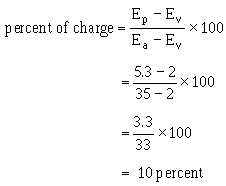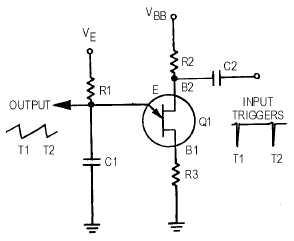3-42
The output waveform is shown in figure 3-45, view (B). With a lower voltage applied from B1 to
B2, the peak and valley points are closer together. Calculating the percentage of charge:
The linearity in this case is good. Using the Universal Time Constant Chart, a 10-percent charge
amounts to 0.1 time constant. The electrical length is, again, RC times the number of time constants. With
R1 at 300 kilohms and C1 at .005 microfarads, the time constant is 1,500 microseconds. One-tenth of a
time constant is equal to 150 microseconds; so the electrical length is 150 microseconds. Prt is the
electrical length plus the fall or flyback time. If C1 discharges from 5.3 volts to 2 volts in 15
microseconds, then the prt is 150 + 15, or 165 microseconds. The prf is about 6 kilohertz
Some unijunction circuits are triggered to obtain a very stable prf. One method is to apply triggers to
B2, as shown in figure 3-46. Negative triggers applied to B2 reduce the inter-base voltage enough to
cause a forward bias condition in the emitter circuit. This cuts off the sweep and allows C1 to discharge
through the B1-to-emitter circuit. Then, C1 recharges until the next trigger arrives and C1 discharges.
Circuit operation and parameters are figured in the same manner as in the previous sawtooth circuits.
Figure 3-46.—Synchronized sawtooth generator.



